Rock music is an electrifying blend of rhythm, melody, and raw emotion. It can energize a crowd, evoke deep emotions, and tell compelling stories.
As well as being a cultural phenomenon, rock music is a testament to the power of creative expression.
That’s why, as a music producer, knowing the most popular rock chord progressions can help you craft tracks that resonate with listeners and capture the essence of rock.
With these rock chord progressions, you can create music that is authentic to the genre and reflects your unique artistic vision.
In today’s article, we’ll break down:
- Understanding rock chord progressions ✓
- Major chords vs. minor chords in rock ✓
- Music theory in rock progressions ✓
- The importance of Roman Numerals ✓
- The top 10 rock chord progressions ✓
- Rhythm guitar creativity & rock theory ✓
- Advanced progression techniques ✓
- Modulating common chord progressions for originality ✓
- Utilizing Drop D & other tunings ✓
- Much more ✓
You’ll be equipped with the knowledge of the most popular rock chord progressions to create songs that stand out and resonate with your audience.
Whether you’re a rock producer, hip-hop producer, or anything in between, you can incorporate that rock edge into your tracks like a pro.
So, let’s dive in…
Table of Contents
- What are Rock Chord Progressions?
- The Role of Chord Progressions in Rock Music
- Major Chords vs. Minor Chords in Rock
- Diving Deeper: Music Theory and Chord Construction
- 10 Common Chord Progressions in Rock Music
- Creativity in Rhythm Guitar and Progression Variations
- Advanced Techniques and Tips for Unique Progressions
- Rock Chord Progressions: Final Thoughts
What are Rock Chord Progressions?

Rock chord progressions form the backbone of rock music, serving as a framework upon which melodies and rhythms are built.
These progressions, a sequence of chords played in a particular order, are essential in creating the distinctive sound of rock music.
Understanding rock chord progressions is crucial for any music producer aiming to craft compelling rock tracks.
At their core, rock chord progressions rely on a combination of major and minor chords structured to evoke various emotions and energy levels.
These progressions can range from simple three-chord sequences to more complex arrangements 一 each bringing a unique flavor to the music.
The versatility of rock chord progressions allows you to create a wide array of unique rock sub-genres.
The beauty of rock/basic chord progressions lies in their adaptability.
To match your creative vision, the same progression can be:
- Modified
- Extended
- Re-arranged
This adaptability makes rock chord progressions a powerful tool in the arsenal of digital music producers and sound designers.
It helps create fresh and original sounds while staying true to the essence of rock music.
The Role of Chord Progressions in Rock Music
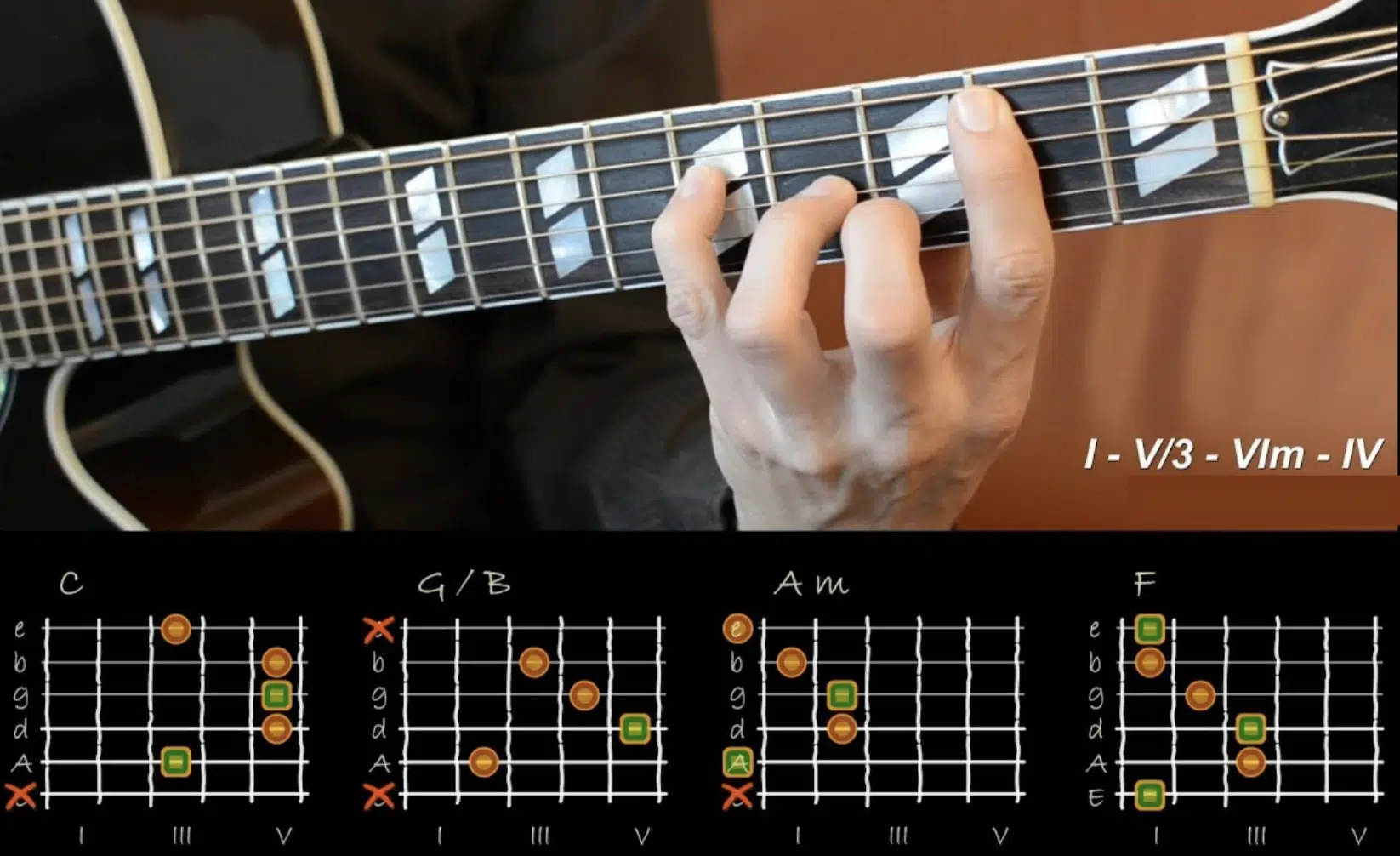
Chord progressions in rock music are not just a series of chords; they are the narrative essence of a song.
They set the tone and mood, guiding the emotional journey of the listener.
In rock music, these progressions can often determine the memorability and impact of a song, making them a critical element for you to master.
The right chord progression can elevate a rock song from good to legendary.
It’s about finding the perfect balance between predictability and surprise, comfort and challenge.
This balance is what keeps listeners engaged and emotionally invested in the song.
It’s all about:
- Experimenting with different combinations
- Infusing them with your unique style
- Adapting them to fit the modern digital production landscape
This creative application sets apart great rock music producers of all kinds.
Understanding this balance is key to creating impactful rock music.
Rock chord progressions have evolved over the years, reflecting the changes in cultural and musical trends.
From the classic simplicity of early rock ‘n’ roll to the more complex and experimental progressions in modern rock, these changes offer a rich tapestry of styles to draw from.
The mastery of rock chord progressions involves not just understanding the music theory but also the ability to apply it creatively.
Major Chords vs. Minor Chords in Rock
The choice between major chords and minor chords in rock music can significantly influence the song’s overall feel and direction.
-
Major chords
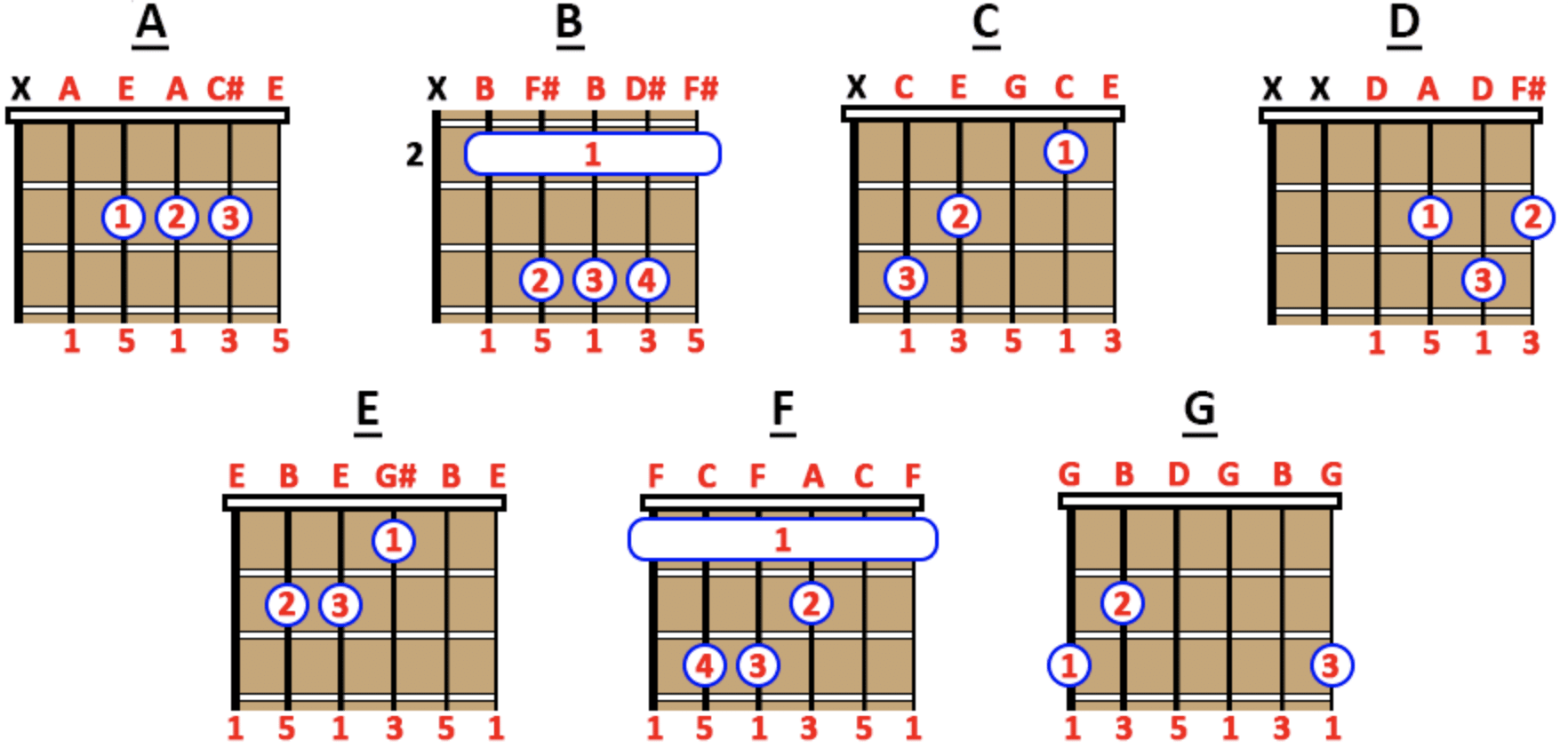
Major chords are often associated with a brighter, more upbeat sound.
-
Minor chords
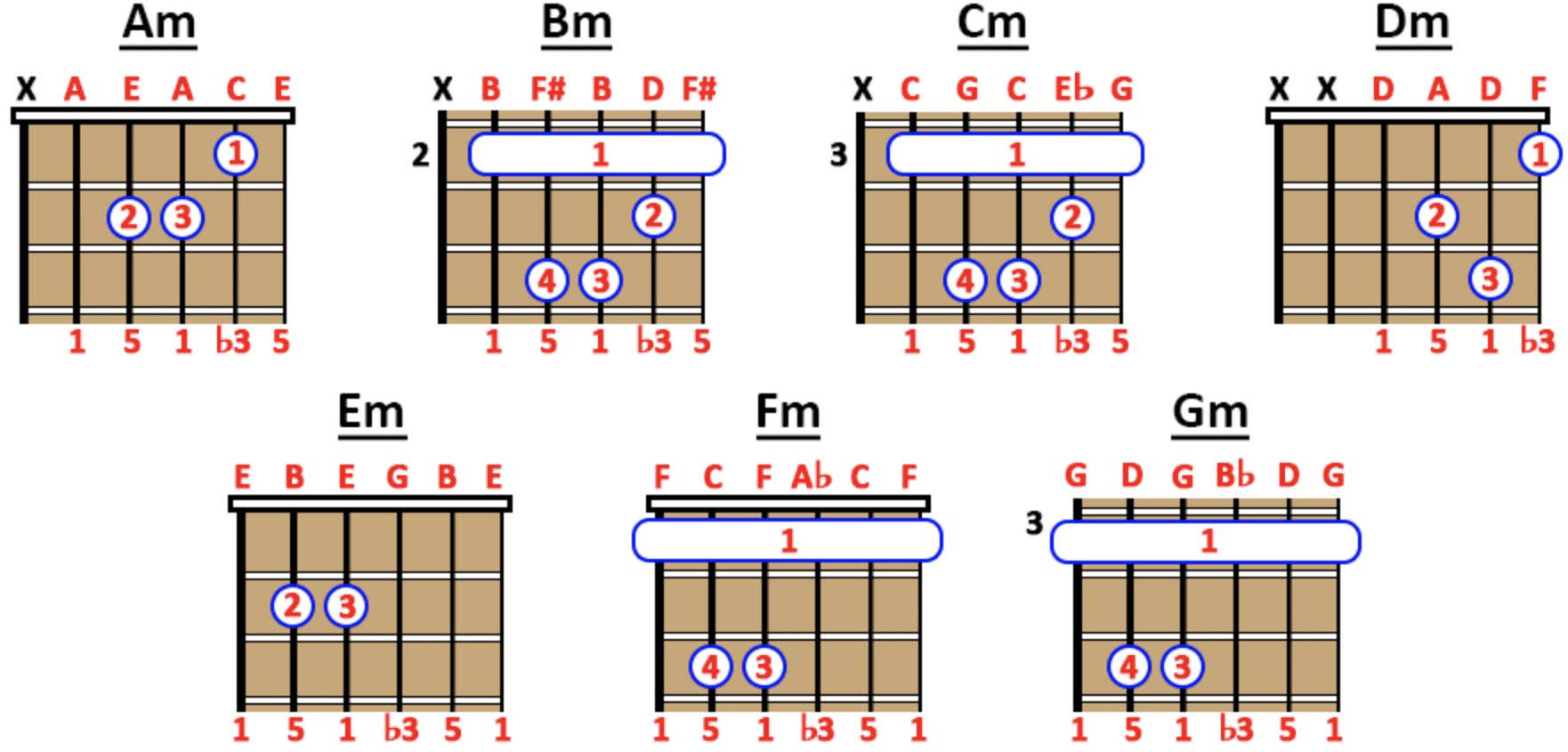
Minor chords evoke a moodier, more introspective feel.
This contrast of chords is central to the emotional expression in rock music.
Understanding the characteristics of major and minor chords is crucial for music producers.
Major chords, consisting of a root note, a major third, and a perfect fifth, tend to sound good, happy, and vibrant.
In contrast, minor chords, made up of a root note, a minor third, and a perfect fifth, have a sadder, more somber tone.
This fundamental difference shapes the emotional landscape of a rock song or guitar solo.
In rock music, the interplay between major chords and minor chords can create a wide range of emotional textures.
A song might start with an upbeat major chord progression, then shift to a minor progression to introduce tension.
This dynamic use of major and minor chords is a powerful tool for storytelling in music.
Choosing between major and minor chords (like G major or E minor) is more than just guitar theory 一 it’s about the emotional journey they want to take their listeners on.
In a major key, like C major, the bright and uplifting sound contrasts starkly with the moodier tones of a minor scale.
This distinction is especially evident when comparing songs in minor keys to those in a singular minor key, revealing how each scale can dramatically shape the emotional essence of rock music.
By skillfully blending major and minor chords, you can craft rock tracks that resonate deeply with your audience and evoke a spectrum of emotions.
You can turn the same chord progression into something entirely different and intriguing.
Diving Deeper: Music Theory and Chord Construction
A deep dive into music theory and chord construction is essential to excel in rock music production, from root notes and sheet music to open chords and chord changes.
This knowledge enhances the understanding of rock chord progressions and opens up new avenues for creativity and innovation in modern music production.
In the following sections, we’ll explore the major scale in rock progressions, the impact of minor chords on rock’s emotional range, and the role of Roman numerals in chord progression analysis.
-
Decoding the Major Scale in Rock Progressions

The major scale forms the foundation of many rock chord progressions.
It consists of seven notes, with a specific pattern of whole and half steps that gives it a distinct sound.
This pattern of the major scale is: whole, whole, half, whole, whole, whole, half.
Understanding this scale is crucial for music producers, as it guides the creation of harmonious chord progressions and melodies in rock music.
In rock chord progressions, the chords are often derived from the notes of the major scale.
Each note of the scale can be turned into a chord, creating a set of seven chords that are harmonically related.
This set includes:
- Major chords
- Minor chords
- Diminished chords
Each plays a very unique role in the progression you’re creating.
Using the major scale in rock music is not just about following a formula; it’s about creatively exploiting the possibilities it offers.
By combining chords from the major scale innovatively, you can create a wide range of moods and textures 一 from uplifting and energetic to somber and introspective.
For digital music producers, the major scale is a valuable tool.
It serves as a roadmap for constructing chord progressions that are both technically sound and emotionally compelling.
A firm grasp of the major scale is essential for anyone looking to create impactful and memorable rock music.
-
The Impact of Minor Chords on Rock’s Emotional Range

Minor chords play a pivotal role in defining the emotional range of rock music.
Their sad and contemplative nature can add depth and complexity to a song, allowing you to explore a broader spectrum of emotional expressions.
The construction of minor chords consists of a:
- Root note
- Minor third
- Perfect fifth
It gives minor chords their distinctively melancholic and reflective sound.
This sound can be used in rock music, creating contrast with brighter major chord sections or setting a consistently moody atmosphere.
In rock chord progressions, the strategic placement of minor chords can dramatically alter the song’s emotional trajectory.
For instance, a chord progression that moves from major to minor chords can mirror a shift from optimism to introspection 一 adding narrative depth to the music.
Understanding the emotional impact of minor chords is crucial for digital music producers.
It allows you to craft other progressions that resonate deeply emotionally, engaging listeners more profoundly and meaningfully.
-
Roman Numerals: Breaking it Down
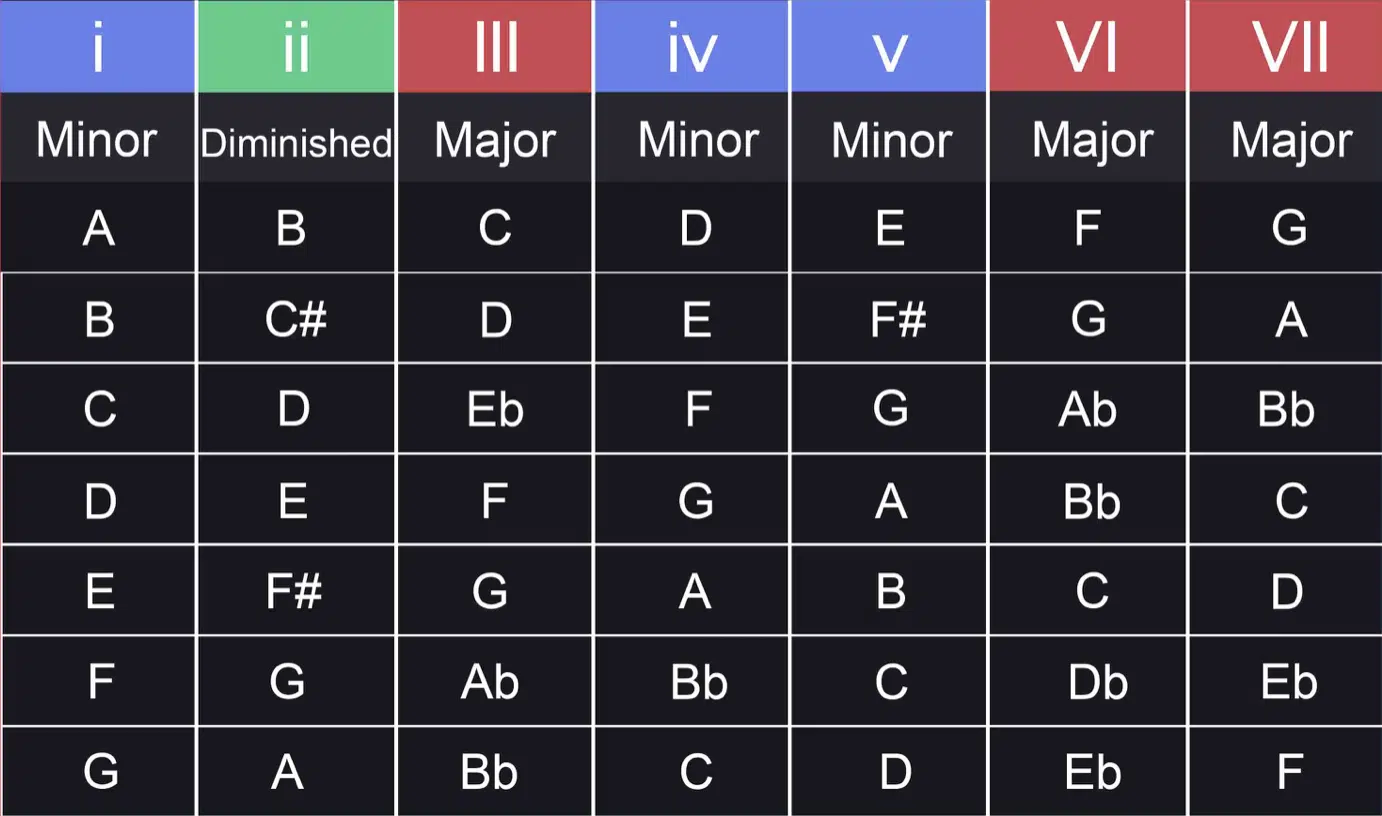
Roman numerals are a vital tool in music theory, used to denote the position of all the chords within a scale.
In rock chord progressions, these numerals provide a universal language for describing the structure and movement of chords, regardless of the key.
Using Roman numerals in analyzing rock chord progressions allows for a clearer understanding of the relationships between chords.
In music theory, Roman numerals signify the chords’ positions within a scale:
- Uppercase numerals (I, IV, V) 一 Represent major chords.
- Lowercase numerals (ii, iii, vi) 一 Represent minor chords.
This provides a clear framework for understanding chord progressions in any key.
It helps you see patterns and common progressions, which can be a source of inspiration for creating new music on your laptop.
Roman numerals can help you transpose chord progressions into different keys effortlessly.
This is especially useful in modern music production, where key changes can add variety and interest to a track.
For those crafting rock chord progressions, Roman numerals are more than just symbols.
They are a gateway to a deeper understanding of music theory and its practical applications.
They empower you to experiment with different chord combinations and understand the underlying structure of your music.
10 Common Chord Progressions in Rock Music
Rock music is renowned for its memorable chord progressions that have shaped the genre.
These rock chord progressions form the heart of many iconic songs, resonating with audiences across generations.
In this section, we’ll explore 10 common chord progressions in rock music, each accompanied by a modern, popular song example that highlights its use.
#1. The Classic Rock Staple
The first progression we will break down is the classic rock staple, the I-IV-V chord progression.
It’s a quintessential element in rock music, forming the basis of many classic tracks.
It utilizes the first, fourth, and fifth chords (three chords) of a major scale.
This combination gives it a simple and dynamic sequence and chord shape.
Its simplicity offers vast creative possibilities, allowing for varied melodic and rhythmic interpretations.
This popular progression is known for its straightforward and energetic vibe, making it a staple in high-spirited rock songs.
A popular and well-recognized example is “Sweet Home Alabama” by Lynyrd Skynyrd.
This song is renowned for its catchy and straightforward I-IV-V chord progression 一 making it an iconic piece in classic rock history.
Its memorable riff and the progression’s simplicity exemplify why this pattern is so fundamental in rock music.
For digital music producers, mastering the I-IV-V chord progression is essential.
It’s a gateway to creating energetic and catchy rock tunes that can appeal to a wide audience, highlighting the timelessness of this classic progression.
#2. The Jazz Influence in Rock
The ii-V-I progression, a staple in jazz, has seamlessly integrated into rock music, offering a more complex harmonic structure.
It consists of the second (ii), fifth (V), and first (I) chords of the major scale.
This combination provides a smooth and sophisticated transition.
Incorporating the ii-V-I progression in rock music brings a touch of elegance and complexity 一 often creating a more introspective and soulful sound.
These three chords are a testament to rock’s versatility and its ability to blend different musical influences.
“Do I Wanna Know?” by Arctic Monkeys, from their 2013 album “AM” is a great example of a song that utilizes this intriguing progression.
This song blends rock with elements of jazz and blues, using the ii-V-I progression to create a moody and atmospheric sound that’s both modern and reflective of classic rock influences.
Digital music producers can use the ii-V-I progression to add a layer of sophistication to their rock compositions.
It challenges the conventional rock sound, opening up avenues for creative exploration.
#3. The Emotional Rollercoaster
The vi-IV-I-V chord progression is renowned for its emotional depth and is often used in rock music to evoke a sense of longing or introspection.
It starts with the sixth (vi) minor chord, followed by the fourth (IV), first (I), and fifth (V) major chords.
This chord progression creates a bittersweet and reflective atmosphere, making it ideal for popular songs that aim to stir deep emotions.
Its popularity in rock music is due to its ability to resonate with the listener’s feelings.
An example of this progression in a modern context is “Someone You Loved” by Lewis Capaldi.
This song demonstrates how the vi-IV-I-V progression can be central to delivering a powerful emotional impact 一 making it a poignant and relatable track.
The vi-IV-I-V chord progression offers a way to infuse their tracks with emotional depth.
It’s especially effective in creating memorable ballads or introspective rock songs that deeply connect with the audience.
#4. The Anthem Formula
The I-V-vi-IV progression is ubiquitous in rock music and is often used to create anthemic and uplifting songs.
It combines the first (I), fifth (V), sixth (vi), and fourth (IV) chords of the major scale.
This chord progression uniquely evokes feelings of triumph and hope, making it a popular choice for rock anthems.
Its universal appeal lies in its balance of predictability and emotional resonance.
“Viva La Vida” by Coldplay exemplifies using the I-V-vi-IV chord progression in a modern rock anthem.
The song’s soaring melody and uplifting rhythm are built around this chord progression 一 showcasing its potential to create impactful and memorable music.
For digital music producers, the I-V-vi-IV progression is a tool for crafting songs with broad appeal.
It’s particularly effective in creating catchy and emotionally engaging tracks, a formula that has proven successful in rock music time and again.
#5. The Subtle Twist
The vi-ii-V-I chord progression adds a twist to the traditional rock sound.
It starts with a minor chord (vi), followed by the second (ii), fifth (V), and first (I) chords.
This rock chord progression offers a mix of introspection and resolution, making it a captivating choice.
This progression’s charm lies in its subtle blend of melancholy and optimism.
It’s ideal for songs that require a nuanced emotional landscape, providing a journey from introspection to a satisfying resolution.
A modern rock song that beautifully utilizes the vi-ii-V-I progression is “Best Day of My Life” by American Authors.
This track showcases how the progression can underpin a song’s optimistic and uplifting theme, delivering a feel-good, energetic vibe.
You can’t imagine how many songs utilize this chord (even by artists like Taylor Swift).
You can leverage the vi-ii-V-I chord progression to create rock tracks with emotion.
It’s beneficial for songs that aim to take the listener on a journey 一 starting from a contemplative mood and building towards a hopeful or triumphant climax.
#6. The Nostalgic Chord Sequence
The I-VI-IV-V progression is a classic sequence in rock music, evoking a sense of nostalgia and timelessness.
It uses the first chord (I), sixth (VI), fourth (IV), and fifth (V) chords.
This creates a sound that is both familiar and comforting.
This popular progression is known for its ability to conjure images of the past, making it a favorite for popular songs that reflect on memories or tell a story.
Its simple structure allows for a focus on lyrics and melody.
“Wake Me Up When September Ends” by Green Day is an excellent example of a modern rock song using the I-VI-IV-V progression.
This chord sequence perfectly complements the song’s reflective and nostalgic tone 一 enhancing its emotional depth.
The I-VI-IV-V progression offers a way to create songs that resonate with familiarity and warmth.
It’s particularly effective for storytelling in music and producing beats that connect with listeners on a personal level.
#7. The Triumphant Progression
The IV-I-V chord progression is another fundamental rock chord sequence known for its triumphant and bold sound.
It starts with the fourth (IV) chord, moves to the tonic (I), and then to the fifth (V) chord.
This creates a progression that’s both uplifting and assertive.
Its strength lies in its straightforward and powerful movement, making it ideal for rock songs that aim to inspire or energize.
Its simplicity also allows for a strong focus on other musical elements like rhythm and melody.
“My Hero” by Foo Fighters exemplifies using the IV-I-V progression in a rock context.
The song’s dynamic and powerful vibe is driven by this chord sequence, demonstrating its ability to create a sense of grandeur.
You can use the IV-I-V progression to infuse their rock tracks with energy and power.
It’s particularly suitable for creating songs that aim to motivate or leave a strong impression 一 harnessing the progression’s straightforward yet impactful nature.
NOTE: In exploring rock guitar chord progressions, notably the iconic E-B transition, pop music producers have found unique ways of playing chords that fuse rock’s intensity with pop songs’ catchy rhythms.
#8. The Emotional Build-up
The I-iii-IV-V chord progression offers a more complex and emotionally layered sound.
Starting with the tonic (I), it moves to the third (iii) chord, which adds a touch of melancholy, followed by the fourth (IV) and fifth (V) chords.
It’s the perfect combination for building tension and release.
This progression is perfect for songs that require an emotional build-up, gradually intensifying the listener’s experience.
The iii chord adds a unique twist, giving the progression a more nuanced and introspective feel.
“Demons” by Imagine Dragons is a modern rock song that effectively uses the I-iii-IV-V chord progression.
The track’s emotional depth and gradual intensity are accentuated by this chord sequence 一 making it both captivating and relatable.
For digital music producers, the I-iii-IV-V progression is a valuable tool for creating tracks with emotional complexity.
It’s especially useful for songs that aim to slowly draw the listener in, building towards a powerful climax.
#9. The Reflective Progression
The I-vi-iii-IV progression is known for its reflective and introspective qualities.
It combines the first chord (I) with a minor sixth (vi), a minor third (iii), and then the fourth (IV) chord.
This one is one of the most impactful when you think of thoughtful and evocative chord progressions.
This chord sequence is ideal for songs that delve into introspection or contemplation.
Its mix of major and minor chords provides a rich tapestry of emotions, allowing for a deeper exploration of themes and feelings.
“Radioactive” by Imagine Dragons showcases the I-vi-iii-IV progression in a contemporary rock setting.
This chord sequence perfectly supports the song’s moody and reflective atmosphere, enhancing its thematic depth and resonance.
For digital music producers and audio engineers, the I-vi-iii-IV chord progression offers a way to craft rock tracks with a more reflective and thoughtful tone.
It’s particularly effective for songs that evoke deeper emotions or provide a space for reflection.
This progression’s blend of major and minor chords allows you to navigate complex emotional landscapes and create music that is both engaging and meaningful.
#10. The Unexpected Turn
The vi-V-IV-III chord progression stands out for its unconventional movement, offering an unexpected twist to traditional chord sequences.
It starts with the minor sixth (vi) chord, followed by the fifth (V) and fourth (IV), and then unusually moves to the major third (III) chord.
The unexpected turn of this chord progression is known for its ability to surprise and captivate listeners.
This makes it ideal for rock songs that seek to break the mold.
Its unexpected chord change adds a unique flavor, setting the song apart from conventional tracks.
“Counting Stars” by OneRepublic is an example of a modern rock song that utilizes the vi-V-IV-III progression effectively.
The song’s catchy and unique sound is partly due to this distinctive chord sequence, which adds an element of surprise and originality.
You can use the vi-V-IV-III chord progression (four chords) to create outstanding rock music.
Its unconventional structure is perfect for producers and artists looking to experiment and push the boundaries of traditional rock music.
Creativity in Rhythm Guitar and Progression Variations
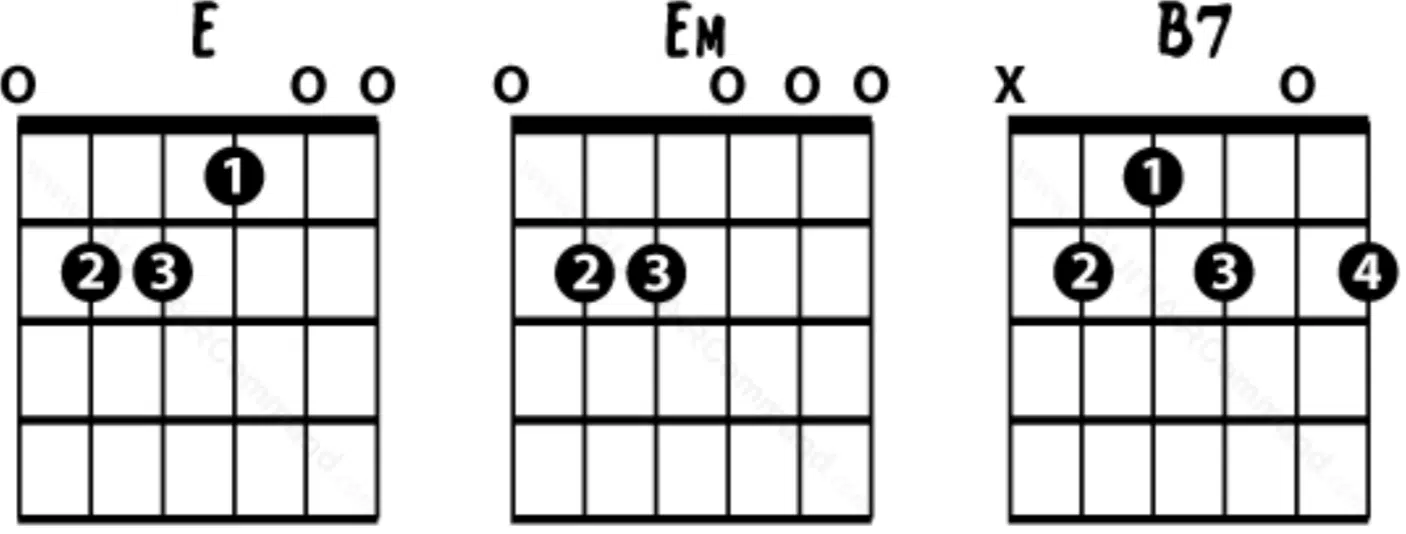
In rock music, the rhythm guitar is crucial in driving the song and adding texture to the chord progressions.
Digital music producers (like yourself) can experiment with different strumming patterns and rhythmic variations to enhance the feel of their rock tracks.
Exploring different chord voicings and inversions can add depth and interest to standard rock chord progressions.
This approach helps you create a fuller, more layered sound, enriching the overall composition.
Remember you don’t have to be playing guitar to learn interesting techniques.
Incorporating elements from other genres, such as blues songs or funk, into rock chord progressions can produce innovative and fresh sounds.
This fusion approach broadens the creative possibilities and keeps the rock genre evolving with different chords.
Creativity in rhythm guitar and rock guitar chord progressions is about pushing the boundaries and experimenting.
By doing so, you can develop your unique style 一 contributing to rock music’s diverse and dynamic world.
Advanced Techniques and Tips for Unique Progressions
As we continue exploring rock/guitar chord progressions, let’s explore advanced techniques and tips to help you create unique and captivating rock tracks.
-
Modulating Common Chord Progressions for Originality
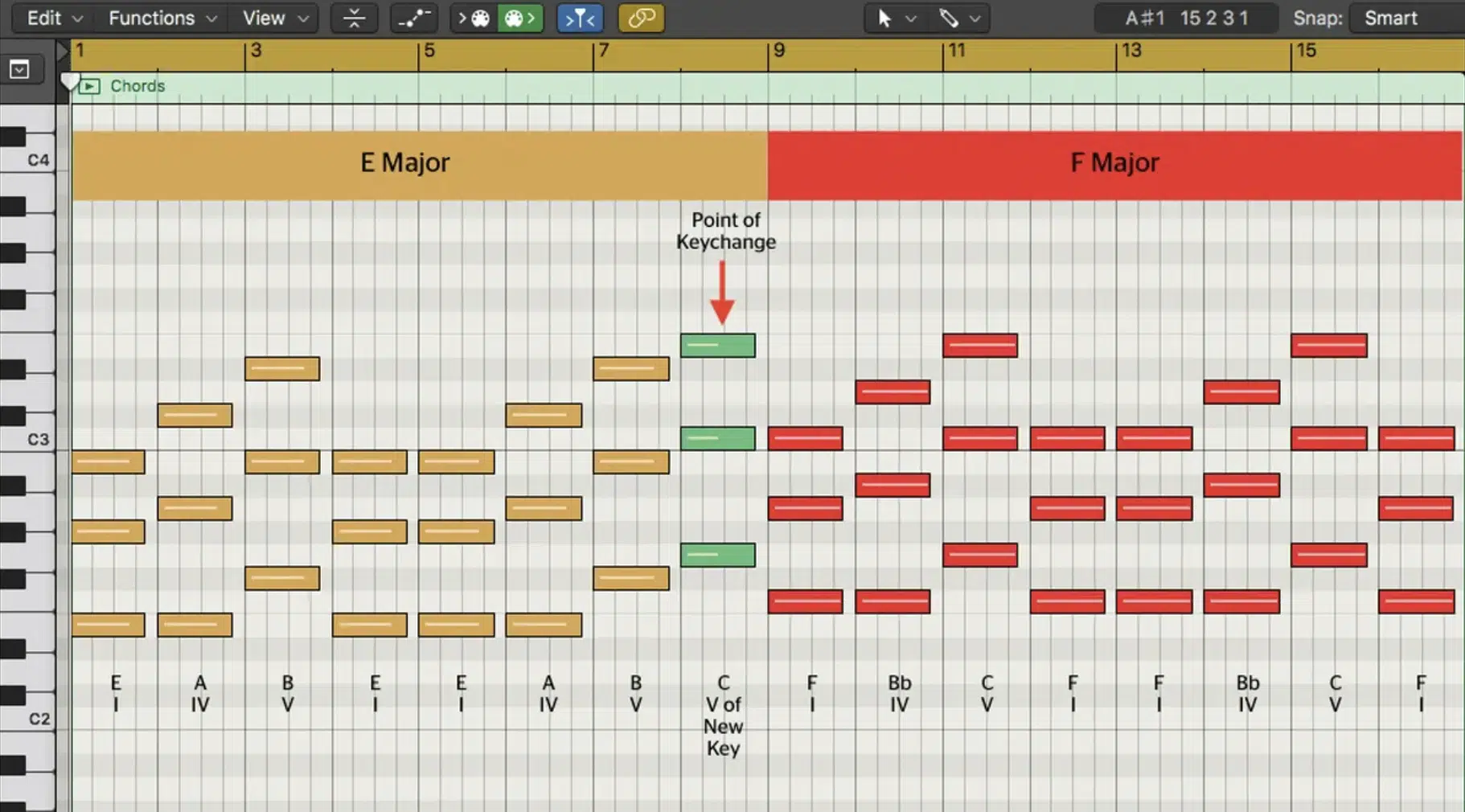
Modulation, the process of changing keys within a song, can breathe new life into common chord progressions.
It adds an element of surprise and keeps the listener engaged.
Shifting the progression key, even a well-worn sequence can sound fresh and exciting.
Modulating rock chord progressions requires a good understanding of music theory, particularly the relationships between different keys.
This knowledge allows you to seamlessly transition between keys 一 maintaining the song’s flow while introducing a new sonic palette.
A practical approach to modulation is to use pivot chords common to both the original and the new key.
This technique provides a smooth and logical transition, enhancing the song’s musicality without jarring the listener.
Experimenting with key changes can unlock new creative potential in your compositions.
It’s a way to stand out in the genre, showcasing technical skills and innovative thinking.
-
Utilizing Drop D and Other Tunings in Rock Progressions
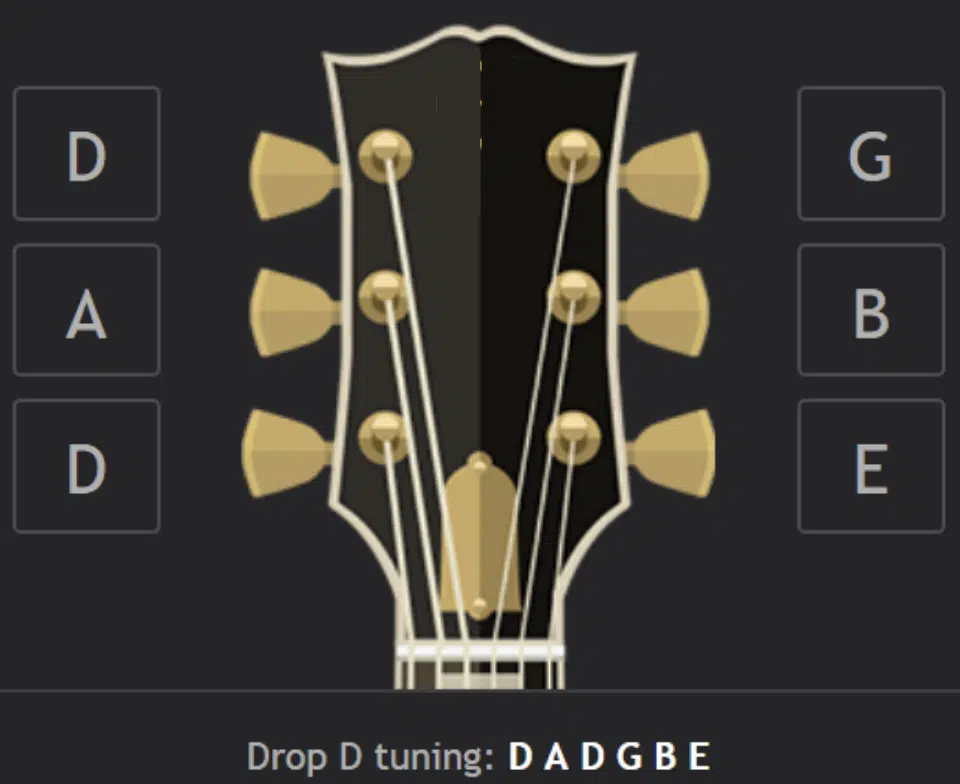
Alternate tunings, such as Drop D (DADGBE), offer a new dimension to rock chord progressions.
These tunings change the guitar’s tonal range and can inspire new chord shapes and sounds, adding depth and originality to rock music.
Drop D tuning, where the lowest string is tuned down a whole step, provides a heavier and more resonant sound.
The guitar gently weeps, in a sense.
It’s trendy in modern rock and metal, as it allows for more effortless playing of power chords and can give a song a more profound, impactful feel.
Beyond Drop D, many other tunings can be explored, like:
- Open G
- DADGAD
- Custom varieties
Each tuning brings unique flavor and challenges, pushing you to think outside the box and explore new harmonic possibilities.
Digital music producers, especially those working with virtual instruments, can easily experiment with these alternate tunings.
This exploration can lead to innovative chord progressions and sounds, distinguishing their music in the competitive world of rock.
Rock Chord Progressions: Final Thoughts
As we’ve explored the dynamic world of rock chord progressions, it’s clear that these musical sequences are more than just a series of chords.
They are the true heartbeat of rock music.
From the emotional depth of minor chords to the uplifting spirit of major chords, understanding and utilizing these rock chordgvprogressions is key to creating impactful rock music.
For those looking to dive even deeper and expand their toolkit, this highly renowed Rock & Metal MIDI Chord Collection is an invaluable resource.
This comprehensive collection offers a vast array of genre-specific progressions for each of the 12 keys, both in major and minor forms.
With 25 major and 25 minor progressions for each key, it opens up a world of possibilities for crafting unique and resonant rock tracks.
Additionally, the collection includes over 35 major and minor genre-specific individual chords for each key 一 equaling a staggering total of 1830 MIDI files.
This wealth of resources allows for endless exploration and experimentation in rock chord progression.
Plus, ensures your tracks stand out and blow the competition away.
Whether you’re a seasoned producer or just starting out, the knowledge of rock chord progressions and tools like this chord pack equips you with everything you need to create compelling rock music.
It’s about blending the timeless with the contemporary (the theory with creativity).
Armed with these tools and insights, you’re now ready to leave your mark in the ever-evolving landscape of rock music.
So, go and create songs that resonate with audiences and capture the true essence of the genre.
Until next time…







Leave a Reply
You must belogged in to post a comment.